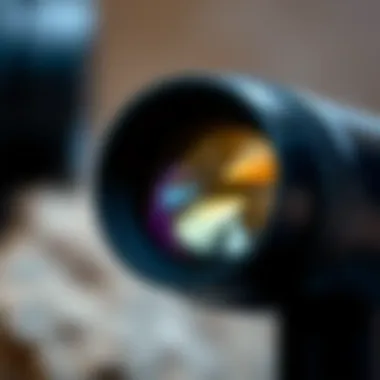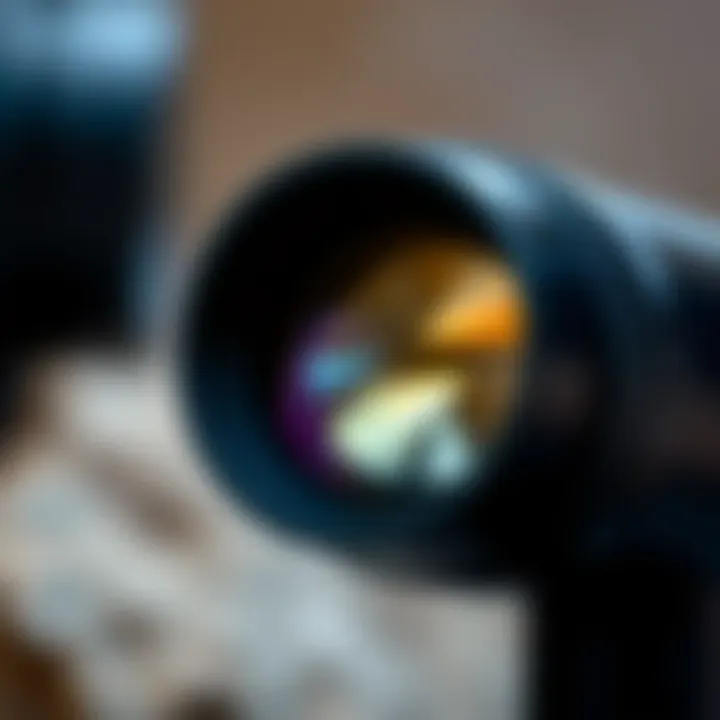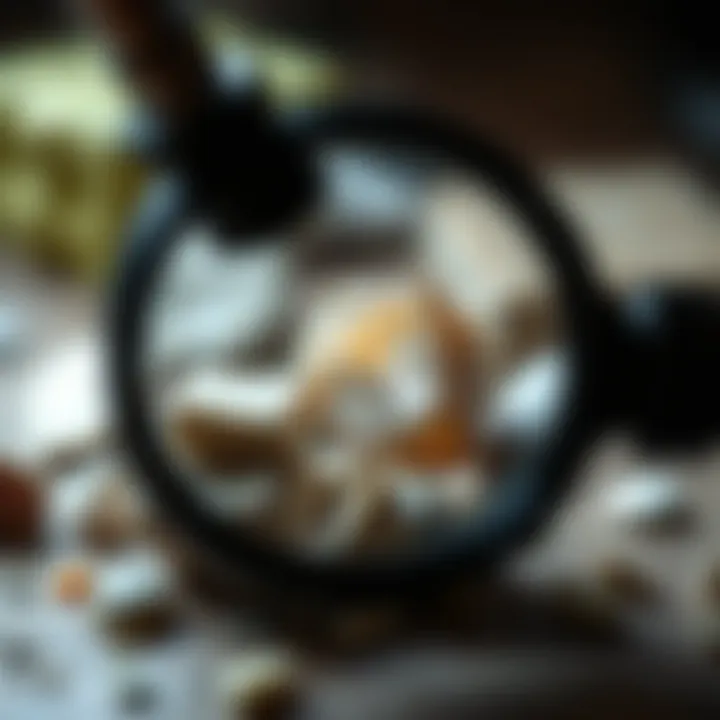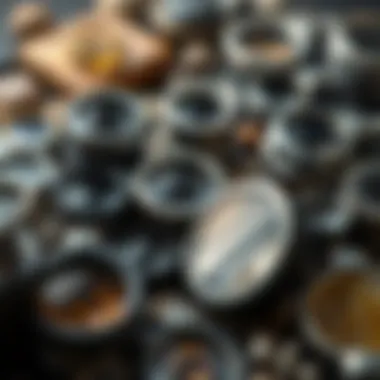Choosing the Best Loupe for Collectors and Hobbyists


Intro
Finding the right loupe is a crucial step for any collector in the realm of geology and natural history. It’s not just about seeing things up close; it’s about enhancing your understanding of the materials you are examining. Whether you’re looking at tiny fossil details or the grains in a rock specimen, a good loupe offers magnification and clarity that can transform an ordinary collection into a rich trove of insights.
In this article, we will dive into essential aspects to keep in mind while selecting a loupe that fits your individual needs.
Featured Collectible of the Month
While many enthusiasts focus on the tools, it’s often the collectible items that capture the imagination. Let’s spotlight an extraordinary collectible: the ammonite. As a stunning relic from the past, ammonites are both beautiful and scientifically significant.
Overview
Ammonites, with their distinct coiled shells, are fascinating representatives of Earth's geologic past. These marine mollusks thrived during the time of the dinosaurs but eventually became extinct about 66 million years ago. Their intricate shell patterns and colors make them popular among collectors.
Historical Significance
The study of ammonites can reveal details about the historical climates and environments they lived in. Fossils can often help scientists understand evolutionary processes and ecological changes over millions of years. Collectors who grasp the significance of these specimens not only appreciate their aesthetic beauty but also their role in narrating the Earth's history.
Identification Techniques
When it comes to collecting, identifying a specimen accurately is half the battle. Accurate identification can enhance your appreciation for each piece in your collection and enable better research and documentation.
Visual Characteristics
When examining a specimen, consider the following key characteristics:
- Shell Shape: Ammonites are recognizable due to their spiral shapes, but they exhibit a variety of forms, from tightly coiled to loosely spiraled.
- Suture Patterns: The patterns on the shell, where the internal chambers are divided, can help in identifying specific species.
- Coloration: The colors can range from muted browns and blacks to vibrant blues and purples, influenced by mineral replacement over time.
Resources for Identification
Several resources can aid you in identifying ammonites effectively. Here are a few:
- Books: Titles like "Ammonites: A Collector's Guide" provide detailed diagrams and identification tips.
- Websites:
- Online Communities: Joining forums like Reddit's Paleontology or specialty groups on Facebook can connect you with fellow collectors for advice and shared experiences.
- Wikipedia on Ammonites offers a comprehensive overview of the group.
- Britannica on Ammonites features historical context and classification.
Having the right loupe enhances all these activities. It makes the minutiae clear and opens up a whole new world of exploration. From the spirals of an ammonite to the layers of a rock, the right tool is your gateway to discovery.
Prolusion to Magnification Tools
Magnification tools play a critical role in providing a closer look at the intricate details often missed by the naked eye. For hobbyists, particularly those interested in geology and natural history, understanding these tools is paramount to making informed collecting decisions. The purpose of this section is to illuminate the essential role loupes play in observation and collecting activities while highlighting significant factors that collectors should consider when choosing the right one.
The benefits of using a loupe extend beyond mere magnification. They enable collectors to examine specimens more meticulously, helping them identify subtle characteristics such as mineral composition, fossil details, and even signs of wear that can indicate the specimen’s age. Essentially, a loupe can transform a mundane observation into a discovery, unlocking secrets hidden within stones and fossils.
When delving into the world of magnification tools, there are key considerations to keep in mind:
- Usage Context: Determining whether the loupe will be used outdoors, in dim lighting, or in controlled environments impacts the choice of features.
- Personal Preference: Some collectors may prefer larger lenses for comfort, while others may seek lighter models for portability.
- Optical Clarity: Not all lenses are created equal; the quality of the lens affects not just magnification but also the clarity of the view.
Thus, understanding magnification tools broadly encompasses not just their specifications, but how they can enhance the overall collecting experience.
The Purpose of a Loupe
Loupes serve a dual purpose: they magnify objects for better visibility and provide the collector with a deeper appreciation of their finds. For those navigating the intricacies of geology or paleontology, a loupe is as vital as a compass or map. It is an indispensable tool that assists in fine-tuning observations, allowing enthusiasts to see textures, patterns, and minute details clearly. In essence, the loupe is like having a window to an unseen world.
A good loupe should amplify not just the size of the items but also one’s understanding of them. Amateur collectors should keep in mind that the quality of magnification reflects the quality of their findings. Cheap solutions may lead to distortions, causing more confusion than clarity.
"In the realm of collecting, clarity often holds the keys to understanding. A good loupe opens more than just visual dimensions; it unlocks knowledge."
Historical Context of Loupes
The journey of loupes through history paints an interesting picture. Originally crafted in the early 1500s, they were primarily designed for jewelers and watchmakers, allowing for precision in their meticulous work. As exploration expanded, so too did the application of these tools. Naturalists and geologists began utilizing loupes in the 18th and 19th centuries to study flora and fauna, which paved the way for further advancements in optical technology.
The design and function of loupes have evolved significantly over the years. Early loupes were rudimentary, often made from glass and assembled with little regard for ergonomics. With advancements in science and engineering, modern loupes are now available in various forms, each promising better quality and ease of use. Collectors now enjoy options like portable LED loupes that illuminate specimens in challenging conditions, or digital loupes that connect to various devices for enhanced viewing.
In summary, understanding the historical backdrop of loupes allows collectors to appreciate their evolution and the immeasurable effects they've had in enhancing our exploration of the natural world. It’s not just a tool but a vestige of human curiosity and ingenuity.
Understanding Loupe Specifications
Understanding the specifications of loupes is crucial for both seasoned collectors and novices in the realm of geology and natural history. This section sheds light on essential elements like magnification power, field of view, and depth of field, which ultimately help you select the most suitable loupe for your specific needs. For collectors, the right loupe can make the difference between a mediocre experience and an exhilarating one, allowing you to dive into the minute details of your specimens.
Magnification Power Explained


Magnification power is one of the most critical specifications of a loupe. It tells you how much closer an object appears compared to the naked eye. For instance, a loupe with 10x magnification makes an object appear ten times larger. Higher magnification is not always better, though. While it offers a closer look, it can reduce the field of view and sometimes distort the image quality.
Consider what you want to observe before choosing. If you're examining large fossils, a lower magnification might work best; it allows you to see the entire piece without feeling like you're squinting through a narrow hole. Conversely, if you're analyzing intricate features, such as fine striations or micro-fossils, a higher magnification might be more appropriate. It's a balancing act that requires thought, but the payoff is significant.
Field of View Considerations
Field of view is another vital aspect to consider when choosing a loupe. It refers to the width of the area you can see when you look through the lens. A larger field of view allows you to scan a broader area, making it easier to locate the detail or specimen you’re initially interested in.
If you imagine trying to find a needle in a haystack, would you rather have a big view that lets you see more of the hay, or a tiny view that only spots a little bit at a time? Similarly, some collectors prefer a wider field of view when identifying fossils in their natural environment compared to a smaller field for intricate details in a lab setting. Choosing the right size can save considerable time, especially when you're out in the field.
Depth of Field Importance
Depth of field refers to how much of the object can remain in focus at a given distance. A variously focused object can lead to additional clarity when looking for specific details. A loupe with a shallow depth of field is excellent for focusing on small areas, while one with a wider depth will allow you to maintain focus on larger sections. The importance of depth of field cannot be overstated.
When traversing rugged terrain to spot rocks or fossils, you want a loupe that allows you to focus on multiple layers within the specimen, providing a more comprehensive view. This is particularly significant for those examining sedimentary layers or looking for particular minerals that may be hidden among others.
"Choosing a loupe is like picking a pair of glasses; the right fit can reveal stunning visual details that were once hidden."
In summary, understanding these specifications significantly enhances your ability to select the optimal loupe. A keen awareness of magnification, field of view, and depth of field can ultimately enrich your collecting experience, making it enjoyable and rewarding.
Types of Loupes Available
Understanding the various types of loupes available is crucial for collectors and hobbyists, particularly those engaged in geology and natural history. Each type of loupe comes with its own set of features, benefits, and limitations that can significantly affect your observational experience. Opting for the right loupe requires a good grasp of your personal needs, whether you’re examining intricate mineral details or scrutinizing the subtle features of fossils.
Standard Loupes
Standard loupes are the classic choice for many enthusiasts. Typically small and lightweight, they are designed to provide clear, magnified views without extra frills. Most standard loupes feature a single lens, usually made from glass or acrylic, and they come in varying magnification powers, commonly ranging between 5x to 10x.
Benefits of standard loupes include:
- Simplicity: Easy to use and generally affordable.
- Versatility: Suitable for various types of observation, from rocks to coins.
- Portability: Compact design makes them easy to carry around.
However, they may not always provide the depth of field or clarity that specialized models do. Collectors often appreciate their straightforward design, yet this type may lack features like built-in illumination, which could be limiting in certain low-light conditions.
LED Loupes
LED loupes have gained popularity thanks to their illumination capabilities. These loupes are equipped with small LED lights that enhance visibility, making it easier to see fine details in specimens, especially in dim areas. The integrated lighting helps illuminate the object without requiring an additional light source, which is beneficial when exploring caves or shaded environments.
Key points to consider with LED loupes:
- Enhanced Visibility: Great for examining darker materials or intricacies in fossils.
- Prolonged Battery Life: Many models are designed to be energy efficient, lasting through several observation sessions.
- Comfortable Use: Often paired with ergonomic designs, reducing hand strain during long periods of observation.
However, the presence of electronics means that some may find them slightly bulkier compared to traditional loupes. It’s wise to assess the quality of light offered by these loupes since poor illumination can lead to distortions.
Digital Loupes
Digital loupes take the traditional concept a step further by incorporating technology. These loupes often feature integrated screens that display the magnified image, allowing for closer examination and documentation. Some digital loupes even connect to computers or smartphones, making it easy to capture images and share findings with others.
Considerations for digital loupes include:
- High-definition Viewing: Offers clearer images with substantial detail.
- Image Capture: Perfect for serious collectors who wish to document their discoveries.
- Flexibility: Multiple magnification settings are often available for various observational needs.
Yet, the reliance on batteries and electronics may deter those who prefer a more straightforward, no-frills experience. As technology continues to evolve, these loupes have become essential in education as well as fieldwork, allowing greater interaction with the specimens studied.
Specialized Loupes for Fossil Collectors
For fossil collectors, using a specialized loupe can make all the difference in uncovering hidden details. These loupes are often equipped with features tailored directly to paleontological inquiries, such as magnification options critical for examining fine textures unique to fossils.
Advantages of specialized loupes include:
- Specific Design: Engineered to handle the particularities of fossils, such as fragile structures.
- Customized Features: Some models come with attachments or interchangeable lenses for various perspectives.
- Robust Materials: Generally constructed with durable materials, they're often tougher against wear and tear common in field conditions.
While they may come at a higher price point than standard or LED loupes, seasoned collectors often view this as a worthwhile investment in enhancing their observational skills and understanding of fossils.
Choosing the right type of loupe is vital for effective collecting and observation. It may seem a bit overwhelming at times, but focusing on your specific needs can guide you to the right tool, ensuring that every specimen you encounter is viewed and understood in the best light.
Key Features to Evaluate
When diving into the world of loupes, it's essential to consider several key features that can significantly impact your specimen observation experience. These aspects help not just with the clarity of what you view, but also with the comfort and usability over long periods, which is particularly important for rock and fossil collectors.
Lens Material and Quality
The material used in making the lens plays a crucial role in how clearly you can see your specimens. High-quality optical glass, for instance, offers superior clarity and brightness compared to plastic lenses. Glass lenses are often coated to improve scratch resistance and reduce glare, allowing for an enhanced viewing experience. Here are essential points about lens materials:


- Clarity: Glass generally delivers better optical performance, providing greater detail.
- Coating Durability: A lens with anti-reflective coating can make a substantial difference, especially in bright conditions, by minimizing light distortion.
- Weight Consideration: While glass is typically heavier, the benefits of clarity often outweigh the drawbacks.
In summary, when choosing a loupe, consider not just the lens size, but also its material and whether it will suit the environments you typically find yourself observing specimens.
Ergonomics and Design
A well-designed loupe can make all the difference between a pleasant observing experience and one that's frustrating. Ergonomics, or how well a device fits into the hand and can be used comfortably, should be top of mind when making your selection. Here are a few crucial elements to take into account:
- Grip Comfort: A loupe with a contoured or rubberized grip can help prevent slipping and fatigue during extended use.
- Weight Distribution: Loupes that are too heavy can cause discomfort; lighter models are generally easier to handle over longer periods.
- Ease of Adjustment: Look for loupes that allow for easy focus adjustment, as this can be a game-changer when examining different specimens.
In essence, the right ergonomic design ensures that while you’re engrossed in the minute details of your collection, your tools remain an extension of your vision, not a hindrance.
Durability and Water Resistance
Durability is key for anyone venturing outdoors to collect and observe specimens. Considering the environments where rocks and fossils may be examined — rain, rocky terrains, or dusty conditions — your loupe must withstand these challenges. Key aspects include:
- Material Strength: Look for models made from sturdy materials such as reinforced plastics or aluminum. These can better endure the inevitable bumps and drops.
- Water Resistance: Some models come with seals that prevent moisture from seeping in, which helps maintain the integrity of the optical components. This feature is highly recommended if you collect in adverse weather or near water bodies.
- Impact Resistance: Loupes with shatter-proof glass or tough outer shells offer additional protection for glass lenses.
Choosing a durable loupe will provide greater confidence during your explorations, allowing you to focus on the hunt rather than worry about damaging your equipment.
"Investing in a high-quality loupe is akin to investing in your own magnifying eyes — seeing the world clearly can open up new avenues for discovery."
Brands and Recommendations
When it comes to selecting the right loupe for your collecting needs, the brands and models you consider can significantly impact your observational experience. Renowned brands have built their reputations over years, offering products that marry quality with reliability. For rock and fossil collectors, this aspect becomes essential, as one aims to examine intricate details and complex structures in specimens. Knowing which brands to trust can save both time and money, and in the world of optical tools, you generally get what you pay for.
Popular Loupe Brands
Numerous manufacturers dominate the market with products tailored for collectors. Noteworthy brands include:
- Bausch & Lomb: Known for their exceptional optical quality, these loupes often come equipped with various magnification options, making them suitable for both novice and experienced collectors.
- Leica: This brand brings precision and durability to the table. Their loupes are typically robust and provide clear images, which is crucial for examining fossils or minerals.
- Celestron: Often regarded for their innovative designs, Celestron provides loupes with integrated lighting, enhancing visibility in less than ideal conditions.
- OptiVISOR: These are great for collectors needing hands-free options. They’re particularly appreciated for their clarity and ease of use, allowing one to observe specimens without straining.
While the general consensus is that investing in a well-known brand ensures a higher likelihood of satisfaction, it is equally important to consider your specific needs and budget.
Comparative Review of Leading Models
Navigating through the range of loupes on the market can feel akin to roaming a labyrinth. Various models by reputable brands each have distinct features that can cater to your individual needs. Here’s a look at some of the leading models:
- Bausch & Lomb Hastings Triplet Loupe: This classic model is celebrated for its high-quality lens that provides significant magnification without distortion. The sturdy construction makes it a dependable choice for lengthy fieldwork.
- Leica ZOOM 2.5x - 5x: Offering adjustable magnification, this model is perfect for collectors who need flexibility. It features a comfortable grip, making it suitable for extended observing sessions.
- Celestron Deluxe Handheld Loupe: Renowned for its built-in LED light, this loupe is ideal for low-light conditions. The impactful light provides clarity and enhances the observation of textures in specimens.
- OptiVISOR series: Good for someone who often works with both hands, these multi-lens loupes allow switching between different magnifications while wearing them without hassle.
When choosing a loupe, consider factors such as optics quality, ease of use, and comfort. It's vital to weigh the specific features of each model against your personal usage patterns and preferences.
"In the realm of optical instruments, quality brand can make the difference between a mere observation and a delightful revelation."
Before you settle on a purchase, read user reviews and performance ratings. Engaging with fellow collectors on forums like Reddit can also provide firsthand experiences that may guide your decision process.
Cost Considerations
When selecting a loupe for your collecting adventures, cost is a pivotal factor. Understanding its significance can save you both time and money in the long run. The right loupe serves as an invaluable tool, enhancing your ability to observe intricate details that make collecting rocks, fossils, and minerals enjoyable and rewarding. However, this advantage can only be realized if you're spending your budget wisely.
It's essential to factor in not just the initial purchase price but also the longevity and functionality of the loupe. Higher costs can sometimes mean better materials, improved optics, and enhanced ergonomics. Thus, it’s important to balance your budget against these long-term benefits. A well-constructed loupe may seem pricey at first glance, yet it can outlast cheaper alternatives—saving you from repeated purchases down the road.
"Investing in quality tools often yields a greater payoff than saving a few bucks with subpar options."
Budget-Friendly Options
For those on a tight budget, don't despair. Affordable loupes can still offer excellent performance. Many budget models provide sufficient magnification and clarity for the average collector. Some brands, like Carson and Opti-Plus, have created loupes that strike a fine balance between price and quality.
It's wise to look for loupes with:
- Basic magnification between 5x and 10x: Offers good detail for most specimen examination.
- Plastic or acrylic lenses: While they may not offer as high a quality as glass, they can be acceptable for casual use.
- Simple designs: A straightforward design can reduce costs without sacrificing functionality.
Researching user reviews on platforms like Reddit or specialist forums can help identify affordable options that meet your needs without breaking the bank. Seek recommendations from fellow collectors who may have already sifted through the noise.
Investing in Quality
On the other hand, investing in a high-quality loupe is not merely a luxury; it’s often a necessity, especially for serious collectors. Quality loupes are crucial for those who require precision and clarity in their observations. A superior lens, constructed of high-grade glass, enhances brightness and reduces distortion, making your observations more insightful.
When considering an investment in quality, prioritize:
- Magnification power: Models featuring higher magnifications—such as 10x to 20x—can reveal details invisible to the naked eye.
- Lens coatings: Multi-coated lenses can improve light transmission, providing clearer views.
- Ergonomics: A comfortable grip helps avoid fatigue during prolonged use, adding to the overall collecting experience.
While quality loupes may come with a higher price tag, they tend to maintain their functionality for years. Thus, think of it as not so much an expense, but an investment in your collecting journey. In the long run, a well-crafted loupe can become a trusted companion, opening up a world of detail in every specimen you encounter.


As you evaluate your options, consider your specific collecting needs and habits. This careful consideration will lead to a better decision, ensuring that your chosen loupe enhances rather than hinders your passion.
Practical Use and Techniques
The practical use and techniques surrounding the utilization of a loupe are paramount for collectors and observers, especially in fields like geology and natural history. Knowing how to effectively use these tools can significantly enhance the experience of examining specimens. The right techniques can also save time and improve the accuracy of your observations. Collectors need to be aware that just having the best loupe isn't enough; understanding how to use it properly can make all the difference.
How to Hold the Loupe Effectively
When it comes to holding a loupe, many enthusiasts might adopt a haphazard approach, yet there’s a method to the madness. A good grip can minimize strain and enhance clarity while viewing specimens. Here are some tips:
- Steady Hands: Use both hands when possible. One hand should hold the loupe while the other stabilizes the specimen or keeps your body steady.
- Eye Distance: Position your eye at the correct distance—too close or too far can distort your view. Typically, a distance of about 3 inches works for most loupes, but some may vary. Adjust accordingly based on what feels comfortable.
- Lighting Considerations: If the loupe has built-in lighting, ensure it’s directed at the specimen for optimal visibility. For handheld loupes, try using a light source that illuminates your specimen adequately.
- Comfort is Key: Make sure you’re in a comfortable position so you can focus on what you’re observing rather than feeling tired from an awkward stance. Leaning against a stable surface might help if you’re observing for extended periods.
"Finding the right grip on your loupe allows for a superior collecting experience. Don’t underestimate the power of proper technique!"
Best Practices for Observing Specimens
Once you have a handle on your loupe, implementing best practices can take your observations to the next level. The key is to balance technique with an understanding of the specimen you’re observing.
- Examine Closely but Quickly: Keep your eye focused on the details, but don’t over-scrutinize without moving the loupe. Shift the loupe periodically to view different angles. This helps in preventing fatigue and offers a more rounded perspective of the specimen.
- Take Notes: While observing, jot down your thoughts or important features that stand out. This will aid in your recollection and analysis later. Mention factors like texture, color, and other unique characteristics.
- Use a Background: If possible, place the specimen against a contrasting background. This can help the finer details pop out, making it easier to spot minerals' imperfections or fossils' subtle features.
- Limit Distractions: When examining a specimen, minimize background noise or interruptions. This can help you focus entirely on the task at hand.
- Wash Your Hands: Always ensure your hands are clean before handling specimens. Oils or dirt from your fingers can obscure important details that a loupe is meant to reveal.
By adopting these techniques and practices, you set yourself up for success in your collecting endeavors. Employing the correct holding techniques and best practices for observing will increase the quality of your findings and enjoyment of each collecting adventure.
Comparing Loupes to Other Tools
When it comes to examining intricate details in the world of geology and natural history, enthusiasts often find themselves with a selection of tools at their disposal. Understanding how loupes compare to other optical devices such as microscopes and binoculars is essential in making an educated choice fitting for one's collectig needs. This section will delve into the specific advantages and limitations of loupes versus these other tools, providing clarity and direction for passionate collectors.
Loupes versus Microscopes
Loupes serve as a convenient
"first look" when it comes to examining minerals, fossils, or plant specimens closely. Unlike microscopes that provide high levels of magnification, loupes typically offer a lower yet sufficient magnification for most casual observations.
Key differences include:
- Magnification Range: Loupes often range between 2x to 10x magnification. In contrast, optical microscopes can magnify objects from 40x up to over 1000x. This means while loupes are excellent for initial inspections, they are not always suited for detailed microscopic analysis.
- Portability: Most loupes are lightweight, compact, and easily fit in a pocket or bag. On the other hand, a microscope can be unwieldy and requires a stable surface for operation.
- Ease of Use: Using a loupe is simple and requires minimal setup. With a microscope, users often need to prepare slides and adjust various knobs to focus effectively, which can be a learning curve for newcomers.
When to Choose a Loupe Over a Microscope:
- If you need a quick inspection of a specimen in the field.
- If portability and ease of use are paramount.
While microscopes certainly have their place in laboratory settings, the casual collector will often find that a good loupe meets their needs without overcomplicating things. The simple mechanics of a loupe allow for immediate observation and appreciation of specimens without the added time and energy required for microscope use.
Loupes versus Binoculars
In another comparison, loupes and binoculars serve different purposes altogether. Binoculars are designed primarily for viewing distant objects, such as birds or natural landscapes, while loupes target close-up details. However, collectors might wonder if binoculars could serve similar purposes in examining larger specimens or geological formations.
Considerations include:
- Optical Design: Loupes use single lenses to magnify close objects, which allows for detailed observations. Binoculars, with their dual lenses, provide a stereoscopic view for depth perception but lack the high magnification necessary for examining textures and fine details.
- Application: Binoculars are better meant for scouting landscapes or spotting wildlife, while loupes shine when scrutinizing geological features, fossil structures, or the minute details on minerals.
- Field Use: If you're in the field looking at rocks in situ, employing binoculars won't help you discern the crystal structure of a mineral; that's where a loupe truly comes to the fore.
When to Choose a Loupe Over Binoculars:
- When examining small or intricate details on specimens.
- For projects that involve close-up work or significant focus on texture and color.
In a nutshell, while binoculars can offer great advantages in different contexts, loupes maintain their unique niche in the world of collecting. The choice ultimately lies with how detailed and close a collector wishes to observe their specimens.
By effectively comparing loupes to microscopes and binoculars, we've established the unique functions and benefits that make loupes indispensable for collectors. No tool can replace the satisfaction obtained from intuitively examining the world at close range—making the loupe an essential companion in any gathering expedition.
Finale and Final Thoughts
As we wrap up this exploration into the world of loupes, it becomes clear that choosing the right loupe is not just a matter of preference but a fundamental aspect of enhancing one’s collecting experience. Collectors in the fields of geology and natural history have a plethora of options at their fingertips. Each type of loupe offers distinct benefits that align with various needs, ensuring that no stone is left unturned in the pursuit of finer details.
Summarizing Key Insights
Throughout this article, key insights have emerged that underline the importance of considering multiple factors when selecting a loupe.
- Magnification Power: Knowing what level of magnification you require is crucial. For instance, hobbyists who focus on microfossils may lean towards higher magnifications, while those looking at larger rocks might find lower magnification just fine.
- Lens Quality: The clarity and quality of the lens play a vital role in how well details can be observed. Scratch-resistant coatings can significantly improve longevity, thus, being an investment in your collecting journey.
- Durability and Ergonomics: A loupe should feel comfortable in your hand and be resilient enough to withstand the rigors of outdoor use. Loupes made from tough materials often offer the best life span.
Understanding these aspects not only aids in making an informed decision but also enhances the overall experience of collecting.
Finding the Right Loupe for You
Choosing the right loupe involves a personal assessment of your specific needs and preferences. Here are a few pointers to help guide you:
- Assess Your Collection: Take into account what you’ll be observing the most. For instance, if your focus is primarily on intricate fossils, this will determine the magnification requirement.
- Hands-On Testing: If accessible, try a few loupes before committing. Some vendors offer a chance to test products out; this can make a world of difference.
- Take Note of Your Environment: If you often find yourself outdoors, consider a loupe that is water-resistant or even an LED option for darker conditions.
- Budget: Lastly, have a clear budget in mind. While premium quality loupes might come with a steeper price tag, sometimes a solid mid-range model does the trick just as well.
Choosing the right loupe is an investment in your collecting journey.
In sum, remember that your loupe is a tool that should enhance your curiosity and excitement as a collector. Putting time into selecting the optimum loupe can immensely enrich your observations, transform your findings into a clearer perspective, and truly elevate your collecting experience.



